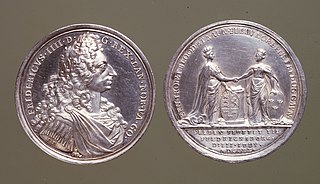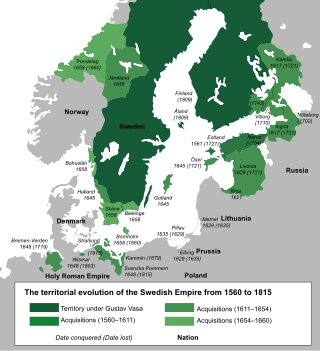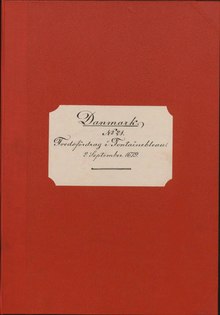
Fontainebleau is a commune in the metropolitan area of Paris, France. It is located 55.5 kilometres (34.5 mi) south-southeast of the centre of Paris. Fontainebleau is a sub-prefecture of the Seine-et-Marne department, and it is the seat of the arrondissement of Fontainebleau. The commune has the largest land area in the Île-de-France region; it is the only one to cover a larger area than Paris itself. The commune is closest to Seine-et-Marne Prefecture, Melun.

Louis XIV, also known as Louis the Great or the Sun King, was King of France from 1643 until his death in 1715. His verified reign of 72 years and 110 days is the longest of any sovereign. Although Louis XIV's France was emblematic of the Age of Absolutism in Europe, the King surrounded himself with a variety of significant political, military, and cultural figures, such as Bossuet, Colbert, Louvois, Le Brun, Le Nôtre, Lully, Mazarin, Molière, Racine, Turenne, Condé, and Vauban.

Charles XI or Carl was King of Sweden from 1660 until his death, in a period of Swedish history known as the Swedish Empire (1611–1721).

The Grand Alliance, sometimes erroneously referred to as its precursor the League of Augsburg, was formed on 20 December 1689. Signed by William III on behalf of the Dutch Republic and England, and Emperor Leopold I for the Habsburg Monarchy, its primary purpose was to oppose the expansionist policies of Louis XIV of France.

The Edict of Fontainebleau was an edict issued by French King Louis XIV and is also known as the Revocation of the Edict of Nantes. The Edict of Nantes (1598) had granted Huguenots the right to practice their religion without state persecution. Protestants had lost their independence in places of refuge under Cardinal Richelieu on account of their supposed insubordination, but they continued to live in comparative security and political contentment. From the outset, religious toleration in France had been a royal, rather than popular, policy.
The Treaties of Stockholm are two treaties signed in 1719 and 1720 that ended the war between Sweden and an alliance of Hanover and Prussia.
Treaty of Fontainebleau may refer to:

The Treaty of Aix-la-Chapelle or Aachen ended the War of Devolution between France and Spain. It was signed on 2 May 1668 in Aachen. Spain acceded on 7 May 1669.

The Treaty of Frederiksborg was a treaty signed at Frederiksborg Castle, Zealand, on 3 July 1720, ending the Great Northern War between Denmark–Norway and Sweden.

The Treaties of Peace of Nijmegen were a series of treaties signed in the Dutch city of Nijmegen between August 1678 and October 1679. The treaties ended various interconnected wars among France, the Dutch Republic, Spain, Brandenburg, Sweden, Denmark-Norway, the Prince-Bishopric of Münster, and the Holy Roman Empire. The most significant of the treaties was the first, which established peace between France and the Dutch Republic and placed the northern border of France very near its modern position.

The Scanian War was a part of the Northern Wars involving the union of Denmark–Norway, Brandenburg and Sweden. It was fought from 1675 to 1679 mainly on Scanian soil, in the former Danish–Norwegian provinces along the border with Sweden, and in Northern Germany. While the latter battles are regarded as a theater of the Scanian war in English, Danish, Norwegian and Swedish historiography, they are seen as a separate war in German historiography, called the Swedish-Brandenburgian War.

Simon Arnauld de Pomponne, Seigneur and then Marquis (1682) of Pomponne was a French diplomat and minister.

Landskrona Citadel is situated in Landskrona, Scania, southern Sweden. Much of the original work is intact. Examples remain of all major parts of the fortification, which is uncommon in such an accessible area. The moat around the central fortification is intact, as are the north-west and north-east parts of the outermost moat, which originally connected to a moat surrounding the city itself. Centermost, the citadel sits on an island surrounded by its own moat. North of the fort, between the second, third and fourth moat is Sweden's oldest allotment-garden. Several of its garden houses are attractions in themselves. Also the fortress castle itself hides both history as such as well as historical horrors, like the 16th Century dungeon in the old western tower, into which the unlucky prisoners were thrown down through a hatch. If surviving the 4-5 meter fall, there then was neither any daylight or any way out. Also the eastern tower has in later centuries served as a prison for those serving life sentences. Around 1900 until 1940 a part of the fortress served as a forced labour institution for vagrant women

Denmark–France relations are the current and historical relations between Denmark and France. Denmark has an embassy in Paris and France has an embassy in Copenhagen. Both countries are full members of the Council of Europe, the European Union and NATO.

The Swedish Empire was the period in Swedish history spanning much of the 17th and early 18th centuries during which Sweden became a European great power that exercised territorial control over much of the Baltic region. The beginning of the period is usually taken as the reign of Gustavus Adolphus, who ascended the throne in 1611, and its end as the loss of territories in 1721 following the Great Northern War.

The Peace of Lund, signed on 16 September (O.S.) / 26 September 1679, was the final peace treaty between Denmark–Norway and the Swedish Empire in the Scanian War.

The Treaty or Peace of Saint-Germain-en-Laye of 19 June (OS) or 29 June (NS) 1679 was a peace treaty between France and the Electorate of Brandenburg. It restored to France's ally Sweden her dominions Bremen-Verden and Swedish Pomerania, lost to Brandenburg in the Scanian War. Sweden ratified the treaty on 28 July 1679.
Events from the year 1679 in Denmark.
Events from the year 1679 in France

Events from the year 1678 in France















